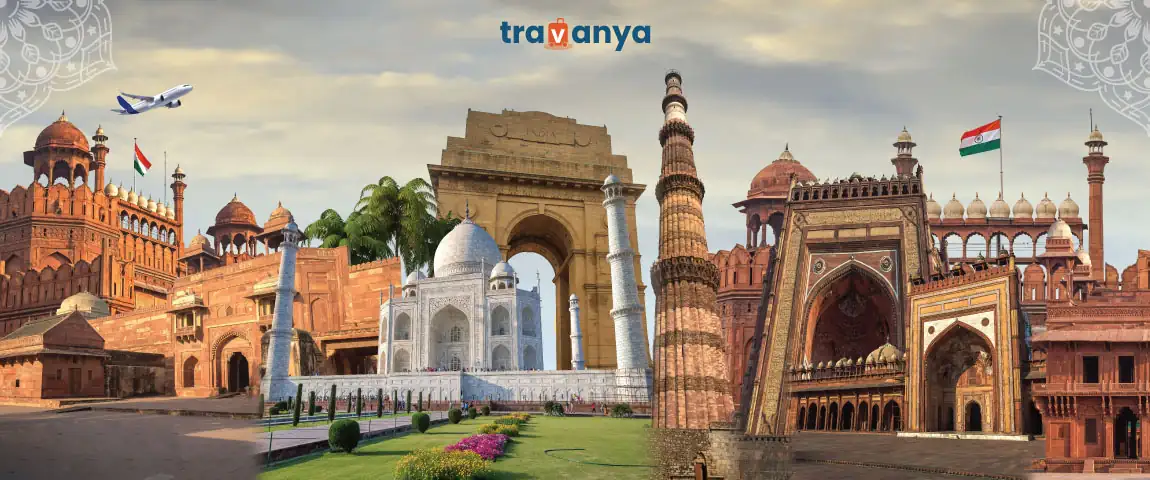
Stories Behind India’s Most Powerful Monuments!!
Posted on Friday, May 2nd, 2025 by Neha Sharma Leave a Comment
Have you ever wondered what it would be like to step back in time? In India, you almost can! The country is brimming with historically significant monuments – incredible structures that offer a glimpse into the lives, beliefs, and artistry of past civilizations. Get ready to explore some of India’s most treasured landmarks and discover the fascinating stories they hold within their walls.
Prominent Historical Monuments of India
1. Taj Mahal, Agra
The Taj Mahal is one of the most beautiful buildings in the world & is known as a symbol of love. It was built by Mughal Emperor Shah Jahan in memory of his beloved wife Mumtaz Mahal, who died while giving birth to their 14th child. Heartbroken by her death, Shah Jahan wanted to build something that would show his eternal love for her.
Construction started in 1632 & was completed around 1648. This beautiful white marble structure stands beside the Yamuna River in Agra. Its beauty lies in its perfect symmetry, beautiful gardens, & the delicate floral designs made with precious stones. When the sunlight hits the dome, it shines like a pearl!
Today, the Taj Mahal is not just a UNESCO World Heritage Site, but also one of the Seven Wonders of the World. Tourists from across the globe visit Agra just to witness this breathtaking monument.
2. Red Fort, Delhi
The Red Fort, or Lal Qila, is a massive fort built using red sandstone. It was constructed by Emperor Shah Jahan in 1648 when he shifted the Mughal capital from Agra to Delhi. The fort served as the main residence of the Mughal emperors for nearly 200 years.
Inside the fort, there are grand halls, beautiful gardens, marble palaces, & mosques. The walls of the fort stretch for over 2 kilometers, making it one of the most impressive forts in India.
After India gained independence in 1947, the Red Fort became a national symbol. Every year on August 15th, the Prime Minister hoists the Indian flag from the fort’s ramparts and delivers a speech to the nation.
3. Qutub Minar, Delhi
The Qutub Minar is the tallest brick minaret in the world, standing at 72.5 meters (about 238 feet). It was started by Qutb-ud-din Aibak in 1192 & later completed by his son-in-law, Iltutmish, & other rulers.
The tower is made of red sandstone & marble, and is covered with beautiful carvings and verses from the Quran. It’s not just a tower but a symbol of the beginning of Muslim rule in India.
Next to the Qutub Minar, there are several other historical buildings, including the Quwwat-ul-Islam Mosque, one of the oldest mosques in India.
4. Hawa Mahal, Jaipur
The Hawa Mahal, also known as the Palace of Winds, is one of Jaipur’s most iconic buildings. It was built in 1799 by Maharaja Sawai Pratap Singh. The building has a unique five-story façade that looks like a honeycomb, with 953 tiny windows known as jharokhas.
These windows allowed the royal women, who followed the strict rules of purdah, to observe daily life & street festivals below without being seen. The windows also let the cool breeze pass through the palace, which is why it’s called the Palace of Winds.
Made from pink sandstone, the Hawa Mahal reflects the beauty of Rajput architecture & is a must-visit when in Jaipur.
5. Victoria Memorial, Kolkata
The Victoria Memorial is a grand white marble building built between 1906 and 1921 in memory of Queen Victoria, the Empress of India during British rule. It was designed by Sir William Emerson & funded by British & Indian officials.
The building mixes British and Mughal architectural styles, with beautiful domes, statues, and well-kept gardens. Today, the Victoria Memorial is a museum and art gallery that holds thousands of paintings, manuscripts, and relics from the colonial period.
It is one of the most popular tourist spots in Kolkata, and its grand structure is especially magical when it is lit up at night.
Sites Integral to India’s Freedom Struggle
1. Jallianwala Bagh, Amritsar
One of the most historical places in India, Jallianwala Bagh, holds a tragic yet powerful memory of India’s fight for freedom. On April 13, 1919, thousands of people had gathered peacefully at Jallianwala Bagh in Amritsar to protest against the Rowlatt Act, which allowed the British to arrest anyone without trial.
Suddenly, General Dyer & his troops entered the garden &, without warning, opened fire on the unarmed crowd. The only exit was blocked. Hundreds of men, women, & even children were killed. Some even jumped into a well inside the garden to escape bullets.
This horrifying incident shook the entire country. It sparked a national awakening & became a major turning point in the Indian freedom struggle movement. The bullet marks on the walls & the martyr’s well are still preserved, reminding us of the price of freedom.
2. Sabarmati Ashram, Ahmedabad
Ashram is located on the banks of the Sabarmati River, This peaceful place was the home of Mahatma Gandhi from 1917 to 1930. More than just a home, Sabarmati Ashram was the heart of many important activities during the national freedom struggle.
It was from here that Gandhi began the Dandi March in 1930 – a non-violent protest against the salt tax imposed by the British. This march became one of the six inspirational freedom movements in India. The ashram was a center for planning civil disobedience, peaceful protests, & promoting swadeshi (use of Indian-made goods).
Today, visitors can explore Gandhi’s living quarters, letters, spinning wheel, & learn about his simple yet powerful lifestyle. Sabarmati Ashram remains a symbol of non-violence and truth, and one of the most important historical places in India.
3. Cellular Jail, Andaman and Nicobar Islands
This jail is known as Kala Pani (meaning black water). The Cellular Jail in Port Blair is one of the most significant historical structures in India. It was built by the British in the 1900s to exile Indian freedom fighters far away from the mainland.
Each prisoner had a tiny individual cell—hence the name Cellular Jail—and most of them faced torture, hunger, & isolation. Many known and unknown freedom fighters, including Veer Savarkar, were imprisoned here. The jail was designed in such a way that prisoners could not communicate with each other.
Today, a light and sound show in the evening tells the story of the sacrifices made by those imprisoned. This monument stands as a powerful symbol of India’s struggle for independence & the hidden freedom fighters of India who gave everything for the nation.
4. August Kranti Maidan, Mumbai
Formerly known as Gowalia Tank Maidan, this ground in Mumbai played a crucial role in India’s history. On August 8, 1942, Mahatma Gandhi launched the Quit India Movement here, calling for the British to leave India immediately.
The slogan “Do or Die” was first raised here, & it electrified the nation. Although the British arrested most Congress leaders soon after, the movement inspired mass protests, strikes, & revolts across India. It was one of the final & most powerful phases of the national freedom struggle.
Today, the park is called August Kranti Maidan, & a stone memorial marks the spot where the historic event took place. It reminds us of the famous movements of India that brought us closer to independence.
5. Lucknow Residency, Lucknow
The Lucknow Residency is a group of buildings that were once used by British officials. But in 1857, during the First War of Independence, it became a battlefield. The Indian sepoys (soldiers) & citizens rose against the British, & the Residency was under siege for months.
This was one of the first freedom struggles in India & marked the beginning of a nationwide revolt. The buildings were damaged by heavy fighting, & many lives were lost on both sides.
Today, the ruins of the Residency stand as a reminder of the bravery of Indian soldiers and civilians who challenged colonial rule. There is also a museum here that tells the history of the Indian independence struggle through photographs, documents, & relics.
Important Dates and Movements in India’s Freedom Struggle
- India’s Freedom Date: August 15, 1947
- First Freedom Struggle: The Revolt of 1857, also known as the First War of Independence
- Non-Cooperation Movement (1920): Led by Mahatma Gandhi, urging Indians to boycott British institutions.
- Civil Disobedience Movement (1930): Marked by the Dandi Salt March, challenging the salt tax.
- Quit India Movement (1942): A mass protest demanding an end to British rule.
FAQs
Q: How did hidden freedom fighters of India contribute from lesser-known historical places?
A: A: Not all freedom fighters gained fame. In regions like the North-East or Central India, many unsung heroes operated from monuments of East India like Netaji’s secret hideouts or tribal resistance points in Chhattisgarh forests. These historical structures in India remain under-acknowledged yet played vital roles in India’s freedom.
Q: What are some activities taken by Mahatma Gandhi in freedom struggle linked to unique locations?
A: A: Beyond the Dandi March and Sabarmati Ashram, Gandhi’s influence spread to small towns like Champaran (Bihar), where he led the first successful Satyagraha for farmers. These places related to Indian freedom struggle and their importance aren’t always mainstream but are essential to understanding his real groundwork.
Q: How do grandparents view the importance of freedom of India compared to younger generations?
A: A: For many grandparents, India freedom date isn’t just a holiday — it’s a lived memory. They recall the emotional weight, the tension, the joy. To them, monuments are not just ruins; they are chapters of sacrifice. This generational perspective offers a deeper emotional appreciation of India’s freedom struggle than historical facts alone.
Q: What are some historical places of Andaman and Nicobar Islands beyond Cellular Jail?
A: A: While the Cellular Jail is iconic, few know about places like Viper Island, where political prisoners were executed even before the jail was built. Other historical places of Andaman and Nicobar Islands include Ross Island, which served as the British administrative center, all crucial to the Indian freedom history.
Q: What were the places of revolt of 1857 in India that sparked chain reactions in the freedom movement?
A: A: Apart from well-known places like Lucknow and Meerut, smaller towns like Jhansi, Arrah, and Bareilly played pivotal roles. These historical places in India with names might not be as touristy, but were hotbeds of rebellion during the first freedom struggle in India.
Q: How are monuments and places of India preserved to educate future generations?
A: A: Many monuments of North India & other regions are being digitized with QR code guides, light-and-sound shows, and virtual walkthroughs. The aim is to keep historical things in India alive for Gen Z and beyond, ensuring these stories never fade into silence.
Q: What famous movement of India had the most unexpected monument association?
A: A: The Quit India Movement is often associated with big cities, but an interesting link exists with August Kranti Maidan, which used to be a regular park. The transformation of this everyday place into a freedom struggle place in India shows how common spaces became revolutionary grounds.
Q: What lesser-known significant places in India are related to tribal or regional revolts?
A: A: Places like Telengana (Batukeshwar Dutt’s movements), Bastar (tribal uprisings), & even Kerala’s Kayyur have deep connections to Indian freedom fighting. These important historical places in India reflect that the struggle was pan-Indian, not just confined to Delhi or Mumbai.
Ready to walk through the pages of India’s past? Whether you want to explore historical places in India or trace the footsteps of the freedom struggle movement, Travanya is here to make your journey unforgettable.Plan your historical getaway now with US! – your trusted travel partner!
Have questions or need help booking your trip? CONTACT US NOW!
About Neha Sharma View All Posts
Neha Sharma, a passionate travel blogger, captures the beauty of the world through her words. With her adventurous spirit and a keen eye for detail, Neha takes her readers on mesmerizing journeys to exotic destinations. Her vivid descriptions and insightful tips make her the go-to guide for wanderlust seekers. Join Neha as she explores the globe, sharing her love for travel and inspiring others to go on their unforgettable adventures.


Leave a Comment